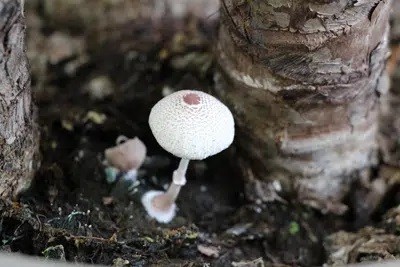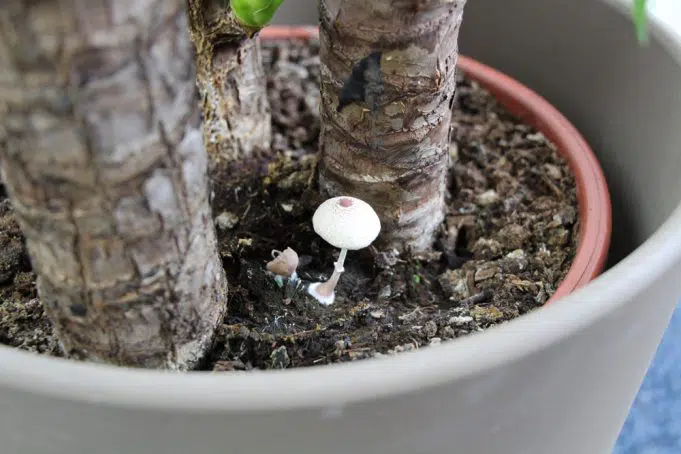Mushrooms in the flower pot show up as a white coating or even as a real mushroom with a cap. Contrary to common belief, the formation of fungus in the pot, however, has less to do with too much moisture. When it occurs, the question arises whether the fungus in the pot could be harmful or poisonous. The following article sheds light on this question and explains where the condition comes from and how to combat it.
Contents
Mushrooms in the flower pot – cause
Often the claim is made that the plants in the container watered too much, the soil is constantly too wet, and therefore there is a formation of fungus. But this is not always the case, the spores can also settle on dry soil and multiply. Thus, experts suspect that one of the main causes of fungal growth in a container is peat additives in the commercial potting soil. This assumption arises from the following knowledge:
- Fungi decompose organic materials
- grow on humus-rich soils
- inferior potting soil has high content
- are therefore more vulnerable
- in addition there is air and soil moisture
- molds prefer warm and humid climate
Thus, in the case of fungi in the flower pot must also always distinguish between a real fungus, as it occurs in the forest and an infestation of other types of fungi, which are often perceived as mold.
Harmfulness
If the first signs of fungal infestation are detected in the container, then, of course, the question immediately arises here whether it is harmful to the plants. If only a few real fungi appear, then this is not a big deal. However, if the area becomes larger and larger, then a water-repellent surface can develop, which can cause the following damage:
- less air penetrates into the soil
- water no longer passes through the surface of the soil
- bottlenecks in oxygen supply through roots
- lack of water
However, a fungal infestation in a pot that is placed in an enclosed space is always dangerous for people and pets. This is because the spores spread in the air of the room and are then inhaled. This can lead to allergies and even asthma if the fungus in the tub is not removed.
Tip: In order to prevent a later fungal infestation in the pot, high-quality potting soil should be used already at the time of planting.
Toxicity
Besides harmfulness, of course, the question arises, are the mushrooms growing in the flower pot poisonous? Usually on the earth in vessels appear the white as well as the yellow fungi. These are molds of the genus Peziza ostracoderma and yellow wrinkled umbrellas of the genus Leucocoprinus birnbaumii. The following is known about them:
- Molds form white coating
- not recognizable as “real” fungi
- dangerous when ingested into the body
- for example adhering to fruit
- give whole fruit into the remainder garbage
- spores can have already penetrated
So far, there is no real evidence of toxicity to the yellow wrinkled umbrellas. However, if there are small children in the household, the wrinkled umbrellas, which may sprout in a container next to a plant, should be removed. This is because children are curious and could put a mushroom in their mouths.
Note: In addition, it has not yet been proven that the spores of the wrinkled umbrellas could cause allergic reactions due to inhalation. However, combating by removing the cause is always advisable in any case
Fight fungi in the flower pot

As soon as you notice the first fungi in the flower pot, you should therefore act immediately for the sake of your own health. It is imperative that the soil in the pot should be completely replaced. The procedure is as follows:
- Remove flower pot from the apartment immediately
- check other pots for infestation as well
- ventilate the apartment well
- ideally for some time on draught
- wear gloves and a mask
- then remove the plant from the pot
- remove all soil from the roots
- dispose of the soil in a closed bag with the residual waste
- clean pot with brush and vinegar solution
- wash the roots of the plant well
If the pot and the plant were cleaned, then you can put them back into the original container. When cleaning, make sure that you thoroughly scrub the inside and outside of the pot with the brush. For planting should be used only high-quality potting soil from the store.
Tip: Even if the high-quality potting soil is a little more expensive, it should be purchased. Because if fungi appear in the flower pot, it will harm your own health and the measures to be taken to combat them require time
Avoid mold
To avoid fungi and especially the dangerous molds in the flower pot, some precautions can be taken from the beginning. These should be as follows:
- Create drainage over drainage hole
- with expanded clay, gravel or shards of clay
- this will prevent waterlogging
- prevent high humidity in the room
- ventilate regularly
- water the plant only when the upper layer is dry
- Water the plant from below via a drainage plate
- always use only high quality soil
Conclusion
It can be assumed that a fungal infection in the flower pot is not dangerous for the plant in a moderate case. Nevertheless, you should definitely fight the fungi in a pot, which is located in the apartment, because the fungal spores that are released can be inhaled, and they can cause allergies, and thus are harmful to all residents of a household. Avoiding the fungi, on the contrary, succeeds with proper care and good quality potting soil.


